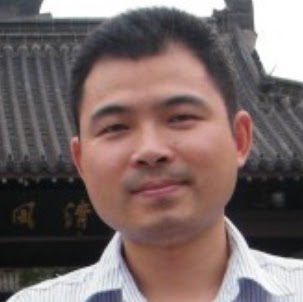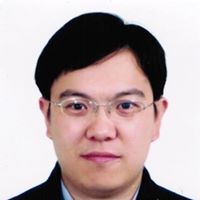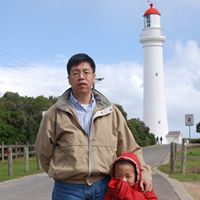Gang A Xu
age ~55
from Katy, TX
- Also known as:
-
- Xu Gang
- Xia Gang
- Xu Gong
- Phone and address:
-
6111 City Shores Ln, Katy, TX 77494
2813947443
Gang Xu Phones & Addresses
- 6111 City Shores Ln, Katy, TX 77494 • 2813947443
- Richmond, TX
- Irvine, CA
- 500 Prospect Rd, Fort Collins, CO 80526
- 905 Laurel St, Fort Collins, CO 80521
- Houston, TX
- Denver, CO
- Durham, NC
Work
-
Company:University of illinois
-
Address:1401 W Green St Rm 42D, Castle Rock, CO 80104
-
Phones:3033870100
-
Position:Associate professor comparative and world literature
-
Industries:Refuse Systems
Resumes

At Gladinet Inc
view sourcePosition:
Testing at Gladinet Inc
Location:
Beijing City, China
Industry:
Information Technology and Services
Work:
Gladinet Inc since Sep 2008
Testing
Alcatel-Lucent Apr 1999 - Aug 2008
MTS
Lucent Technologies 1999 - 2008
MTS
Testing
Alcatel-Lucent Apr 1999 - Aug 2008
MTS
Lucent Technologies 1999 - 2008
MTS
Education:
University of Alabama 1997 - 1999
MS, Computer Science China University of Mining and Technology 1993 - 1996
MS, Power Electronics Xiamen University 1989 - 1993
BS, Computer Science
MS, Computer Science China University of Mining and Technology 1993 - 1996
MS, Power Electronics Xiamen University 1989 - 1993
BS, Computer Science

Senior Surveyor
view sourceIndustry:
Maritime
Work:
Lloyd's Register Group Limited
Senior Surveyor
Lloyd's Register Apr 2009 - Dec 2017
Senior Surveyor In Charge For Wuhan Office
Lloyd's Register Jul 2007 - Feb 2009
Senior Surveyor
Lloyd's Register 2002 - 2007
Project Manager
Lloyd's Register 1997 - 2002
Material Surveyor
Senior Surveyor
Lloyd's Register Apr 2009 - Dec 2017
Senior Surveyor In Charge For Wuhan Office
Lloyd's Register Jul 2007 - Feb 2009
Senior Surveyor
Lloyd's Register 2002 - 2007
Project Manager
Lloyd's Register 1997 - 2002
Material Surveyor
Education:
University of Warwick - Wmg 1996 - 1996
Associates, Business Management, Engineering Xi'an Jiaotong University 1978 - 1982
Bachelors
Associates, Business Management, Engineering Xi'an Jiaotong University 1978 - 1982
Bachelors

Senior Software Developer
view sourceLocation:
Katy, TX
Industry:
Information Technology And Services
Work:
Bluware, Inc.
Senior Software Developer
Exxonmobil Apr 2018 - Mar 2019
Business Data Science Expert
Omni Ai, Inc. Feb 2017 - Mar 2018
Principal Research Scientist
Giant Gray, Inc. Mar 2016 - Feb 2017
Senior Research Scientist
Behavioral Recognition Systems, Inc. (Brs Labs) Jan 2013 - Mar 2016
Senior Research Scientist
Senior Software Developer
Exxonmobil Apr 2018 - Mar 2019
Business Data Science Expert
Omni Ai, Inc. Feb 2017 - Mar 2018
Principal Research Scientist
Giant Gray, Inc. Mar 2016 - Feb 2017
Senior Research Scientist
Behavioral Recognition Systems, Inc. (Brs Labs) Jan 2013 - Mar 2016
Senior Research Scientist
Education:
Colorado State University 2002 - 2006
Doctorates, Doctor of Philosophy, Computer Engineering
Doctorates, Doctor of Philosophy, Computer Engineering
Skills:
Machine Learning
Linux
Natural Language Processing
Matlab
C++
Algorithms
Neural Networks
Artificial Intelligence
Perl
Statistics
Parallel Programming
Programming
Mpi
Software Engineering
Data Mining
Image Processing
Computer Vision
Digital Image Processing
Java
Mysql
Fortran
C
Pattern Recognition
Signal Processing
Distributed Systems
Computer Science
Latex
Cuda/Gpu
Lisp
Hadoop
High Performance Computing
Mapreduce
Software Development
Keras
Theano
Python
Haskell
Mxnet
Agile Environment
Scrum
Random Forest
Boosting Trees
Research
Algorithm Design
Statistical Modeling
Javascript
Sql
Testing
Linux
Natural Language Processing
Matlab
C++
Algorithms
Neural Networks
Artificial Intelligence
Perl
Statistics
Parallel Programming
Programming
Mpi
Software Engineering
Data Mining
Image Processing
Computer Vision
Digital Image Processing
Java
Mysql
Fortran
C
Pattern Recognition
Signal Processing
Distributed Systems
Computer Science
Latex
Cuda/Gpu
Lisp
Hadoop
High Performance Computing
Mapreduce
Software Development
Keras
Theano
Python
Haskell
Mxnet
Agile Environment
Scrum
Random Forest
Boosting Trees
Research
Algorithm Design
Statistical Modeling
Javascript
Sql
Testing
Languages:
Mandarin
English
English

Educational Consultant
view sourceIndustry:
Education Management
Work:
Bcepd
Educational Consultant
Educational Consultant

Gang Xu
view source
Gang Xu
view source
Gang Xu
view sourceLocation:
United States
Lawyers & Attorneys

Gang Xu - Lawyer
view sourceLicenses:
New York - Currently registered 1995
Education:
Georgetown Univ Boston U

Gang Xu - Lawyer
view sourceLicenses:
Virginia - Authorized to practice law 1997
Medicine Doctors

Gang Xu
view sourceSpecialties:
Anatomic Pathology & Clinical Pathology
Education:
Peking Union Medical University (1994)
Isbn (Books And Publications)

Epipolar Geometry in Stereo, Motion and Object Recognition: A Unified Approach
view sourceAuthor
Gang Xu
ISBN #
0792341996
Name / Title
Company / Classification
Phones & Addresses
Associate Professor Comparative And World Literature
University of Illinois
Refuse Systems
Refuse Systems
1401 W Green St Rm 42D, Castle Rock, CO 80104
President
BEST CORNER GENERAL TRADING CORP
1209 John Reed Ct STE A, Hacienda Heights, CA 91745
1209 John Reed Ct, Whittier, CA 91748
1209 John Reed Ct, Whittier, CA 91745
1209 John Reed Ct, Whittier, CA 91748
1209 John Reed Ct, Whittier, CA 91745
Principal
G.L.G. Express Inc
Business Services at Non-Commercial Site
Business Services at Non-Commercial Site
72 Deer Crk Rd, Pomona, CA 91766
Principal
Argos Construction Inc
Single-Family House Construction
Single-Family House Construction
2331 S 2 Ave, Arcadia, CA 91006
WESTLAKE ES LLC
President
YONGXIN INTERNATIONAL, INC
17870 Castleton St STE 109, Rowland Heights, CA 91748
17870 Castleton St, Whittier, CA 91748
17870 Castleton St, Whittier, CA 91748
President
DONG YUAN INTERNATIONAL CORPORATION
1977 1979 W Holt Ave, Pomona, CA 91768
Us Patents
-
Method And Apparatus For Providing Differencing Multistage Detection In The Reverse Link Of A Code Division Multiple Access Communication System
view source -
US Patent:6529495, Mar 4, 2003
-
Filed:May 24, 1999
-
Appl. No.:09/317333
-
Inventors:Joseph R. Cavallaro - Pearland TX
Gang Xu - Houston TX -
Assignee:Nokia Telecommunications, Oy
-
International Classification:H04B 7216
-
US Classification:370342, 375148, 375150
-
Abstract:A multistage detector is disclosed that maximizes computation power while minimizing system delay. The differencing multistage detector receives signals from a plurality of users in a cell of a communications system and reduces the effect of multiple access interference to a signal from a desired user caused by interference from other users in the cell. The differencing multistage detector includes a plurality of stages, each stage including an interference canceller for removing intra-cell interference caused by the other users in the cell and producing an estimation output vector, wherein except for a first stage, the estimation output vector of a current stage is based on both a decision of the interference canceller of the current stage and the output from an interference canceller of a previous stage. The estimation output vector of a current stage is produced by combining the output from an interference canceller of a previous stage and the decision of the interference canceller of the current stage. Except for the first stage each interference canceller calculates an estimate of multi-user interference by computing a product of a cross-correlation of the received signals and a difference signal thereby reducing the number of multiplication operations required.
-
System And Method For Efficient Computation Of Simulated Thermodynamic Property And Phase Equilibrium Characteristics Using Comprehensive Local Property Models
view source -
US Patent:7676352, Mar 9, 2010
-
Filed:Apr 19, 2005
-
Appl. No.:11/109840
-
Inventors:David J. Van Peursem - Irvine CA, US
Gang Xu - Corona CA, US -
Assignee:Invensys Systems, Inc. - Foxboro MA
-
International Classification:G06F 9/455
-
US Classification:703 9, 703 2, 73 2501, 137828
-
Abstract:A method of estimating a thermophysical property of a fluid using a local model is disclosed herein. The method includes generating, for use within the local model, a series expansion of thermodynamic equations relating to the thermophysical property and one or more derivatives involving the thermophysical property. The method further includes evaluating, based upon a set of specified values of parameters of the fluid, a first order term of the series expansion and a second order term of the series expansion. The values of the first order term and the second order term are then compared. A value of the thermophysical property is then automatically updated when the values of the first order term and the second order term are found to differ by more than a predefined amount.
-
Dynamic And Adaptive Radar Tracking Of Storms (Darts)
view source -
US Patent:7843378, Nov 30, 2010
-
Filed:Mar 4, 2008
-
Appl. No.:12/074511
-
Inventors:Chandrasekaran Venkatachalam - Fort Collins CO, US
Gang Xu - Houston TX, US
Yanting Wang - Aurora CO, US -
Assignee:Colorado State University Research Foundation - Fort Collins CO
-
International Classification:G01S 13/95
-
US Classification:342 26R, 342 26 D, 342196
-
Abstract:Methods and systems for estimating atmospheric conditions are disclosed according to embodiments of the invention. In one embodiment, a method may include receiving reflective atmospheric data and solving a flow equation for motion coefficients using the reflective atmospheric data. Future atmospheric conditions can be estimated using the motion coefficients and the reflective atmospheric data. In another embodiment of the invention, the flow equation is solved in the frequency domain. Various linear regression tools may be used to solve for the coefficients. In another embodiment of the system, a radar system is disclosed that predicts future atmospheric conditions by solving the spectral flow equation.
-
System And Method For Efficient Computation Of Simulated Thermodynamic Property And Phase Equilibrium Characteristics Using Comprehensive Local Property Models
view source -
US Patent:7987082, Jul 26, 2011
-
Filed:Feb 1, 2010
-
Appl. No.:12/698063
-
Inventors:David J. Van Peursem - Irvine CA, US
Gang Xu - Corona CA, US -
Assignee:Invensys Systems, Inc. - Foxboro MA
-
International Classification:G06F 9/455
-
US Classification:703 9, 73 2501
-
Abstract:A method of estimating a thermophysical property of a fluid using a local model is disclosed herein. The method includes generating, for use within the local model, a series expansion of thermodynamic equations relating to the thermophysical property and one or more derivatives involving the thermophysical property. The method further includes evaluating, based upon a set of specified values of parameters of the fluid, a first order term of the series expansion and a second order term of the series expansion. The values of the first order term and the second order term are then compared. A value of the thermophysical property is then automatically updated when the values of the first order term and the second order term are found to differ by more than a predefined amount.
-
Long-Term Memory In A Video Analysis System
view source -
US Patent:8121968, Feb 21, 2012
-
Filed:Sep 11, 2008
-
Appl. No.:12/208551
-
Inventors:John Eric Eaton - Houston TX, US
Wesley Kenneth Cobb - The Woodlands TX, US
Ming-Jung Seow - Houston TX, US
David Samuel Friedlander - Houston TX, US
Gang Xu - Houston TX, US -
Assignee:Behavioral Recognition Systems, Inc. - Houston TX
-
International Classification:G06F 17/00
G06F 15/18
G06N 5/02
G06K 9/62
G06K 9/46
G06K 9/66 -
US Classification:706 46, 706 12, 382155, 382192, 382227
-
Abstract:A long-term memory used to store and retrieve information learned while a video analysis system observes a stream of video frames is disclosed. The long-term memory provides a memory with a capacity that grows in size gracefully, as events are observed over time. Additionally, the long-term memory may encode events, represented by sub-graphs of a neural network. Further, rather than predefining a number of patterns recognized and manipulated by the long-term memory, embodiments of the invention provide a long-term memory where the size of a feature dimension (used to determine the similarity between different observed events) may grow dynamically as necessary, depending on the actual events observed in a sequence of video frames.
-
Detecting Anomalous Events Using A Long-Term Memory In A Video Analysis System
view source -
US Patent:8126833, Feb 28, 2012
-
Filed:Dec 16, 2008
-
Appl. No.:12/336354
-
Inventors:Wesley Kenneth Cobb - The Woodlands TX, US
Ming-Jung Seow - Houston TX, US
Gang Xu - Houston TX, US -
Assignee:Behavioral Recognition Systems, Inc. - Houston TX
-
International Classification:G06F 17/00
G06F 15/18
G06N 5/02
G06K 9/62
G06K 9/46
G06K 9/66 -
US Classification:706 46, 706 12, 382155, 382192, 382227
-
Abstract:Techniques are described for detecting anomalous events using a long-term memory in a video analysis system. The long-term memory may be used to store and retrieve information learned while a video analysis system observes a stream of video frames depicting a given scene. Further, the long-term memory may be configured to detect the occurrence of anomalous events, relative to observations of other events that have occurred in the scene over time. A distance measure may used to determine a distance between an active percept (encoding an observed event depicted in the stream of video frames) and a retrieved percept (encoding a memory of previously observed events in the long-term memory). If the distance exceeds a specified threshold, the long-term memory may publish the occurrence of an anomalous event for review by users of the system.
-
Behavioral Recognition System
view source -
US Patent:8131012, Mar 6, 2012
-
Filed:Feb 8, 2008
-
Appl. No.:12/028484
-
Inventors:John Eric Eaton - Houston TX, US
Wesley Kenneth Cobb - Woodlands TX, US
Dennis Gene Urech - Katy TX, US
Bobby Ernest Blythe - Houston TX, US
David Samuel Friedlander - Houston TX, US
Rajkiran Kumar Gottumukkal - Houston TX, US
Lon William Risinger - Katy TX, US
Kishor Adinath Saitwal - Houston TX, US
Ming-Jung Seow - Houston TX, US
David Marvin Solum - Houston TX, US
Gang Xu - Houston TX, US
Tao Yang - Houston TX, US -
Assignee:BEHAVIORAL RECOGNITION SYSTEMS, Inc. - Houston TX
-
International Classification:G06K 9/00
-
US Classification:382103, 382155, 3405731
-
Abstract:Embodiments of the present invention provide a method and a system for analyzing and learning behavior based on an acquired stream of video frames. Objects depicted in the stream are determined based on an analysis of the video frames. Each object may have a corresponding search model used to track an object's motion frame-to-frame. Classes of the objects are determined and semantic representations of the objects are generated. The semantic representations are used to determine objects' behaviors and to learn about behaviors occurring in an environment depicted by the acquired video streams. This way, the system learns rapidly and in real-time normal and abnormal behaviors for any environment by analyzing movements or activities or absence of such in the environment and identifies and predicts abnormal and suspicious behavior based on what has been learned.
-
Thermodynamic Process Control Based On Pseudo-Density Root For Equation Of State
view source -
US Patent:8165860, Apr 24, 2012
-
Filed:Aug 25, 2009
-
Appl. No.:12/547145
-
Inventors:Gang Xu - Irvine CA, US
David Bluck - Yorba Linda CA, US
David J. Van Peursem - Irvine CA, US
Ian H. Boys - Vista CA, US -
Assignee:Invensys Systems, Inc - Foxboro MA
-
International Classification:G06F 9/455
-
US Classification:703 12
-
Abstract:A system for thermodynamic modeling is provided. The system comprises a computer having a processor, a thermodynamic process simulation application, and a thermodynamic equation of state application. When executed by the processor, the thermodynamic equation of state application determines a density root based on a first and second point of departure from an equation of state and based on a first and a second extrapolation equation. The first departure point satisfies the equation.
Classmates

Gang Xu | Old Dominion Un...
view source
Mayall Street Elementary ...
view sourceGraduates:
Bruce Rosenblum (1961-1966),
Roberta Pierce (1964-1967),
Avis Bulbulyan (1988-1993),
Gang Xu (1990-1993)
Roberta Pierce (1964-1967),
Avis Bulbulyan (1988-1993),
Gang Xu (1990-1993)

A Driving School, Calgary...
view sourceGraduates:
Xu Gang (1996-2000),
Oluseyi Seyi (2002-2006),
Mamasa Coppola (1976-1980),
Talia Starr Derksen (1986-1990)
Oluseyi Seyi (2002-2006),
Mamasa Coppola (1976-1980),
Talia Starr Derksen (1986-1990)
Youtube
Plaxo

Gang xu
view sourceSales Manager at ABB

Gang Xu
view sourceAttorney at Morrison & Foerster LLP

Gang Xu
view sourcePAREXEL International
Googleplus

Gang Xu
Education:
University of South Carolina - International Hospitality and Tourism Management

Gang Xu

Gang Xu

Gang Xu

Gang Xu

Gang Xu

Gang Xu
About:
穷则独善其身,达则兼...

Gang Xu

Gang Xu
view source
Gang Xu
view source
Xu Gang
view source
Gang Xu
view source
Gang Xu
view source
Gang Xu
view source
Gang Xu
view source
Gang Xu
view sourceFlickr
Get Report for Gang A Xu from Katy, TX, age ~55













